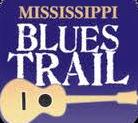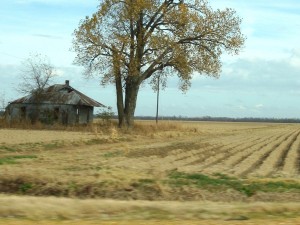» posted on Monday, December 3rd, 2012 by Linda Lou Burton
Delta Dawning
 Linda Burton posting from Jackson, Mississippi – I’m in Jackson now. Praise be, I got the show on the road without too much fanfare this morning; no cats hid under the bed and commute traffic had thinned by the time I started driving. It’s 265 miles or so from Little Rock to Jackson, depending on where you cross the river, so I knew I’d get to my next new home well before dark. Freeways don’t make a direct connection; state roads lead from one chunk of interstate to another, though not in a straight line. Some of the highways were two-lane but I didn’t mind; the slower pace gave me more time to enjoy the countryside, never far from the Mississippi River, or pieces of it now landlocked in oxbow lakes. Every inch of the rich
Linda Burton posting from Jackson, Mississippi – I’m in Jackson now. Praise be, I got the show on the road without too much fanfare this morning; no cats hid under the bed and commute traffic had thinned by the time I started driving. It’s 265 miles or so from Little Rock to Jackson, depending on where you cross the river, so I knew I’d get to my next new home well before dark. Freeways don’t make a direct connection; state roads lead from one chunk of interstate to another, though not in a straight line. Some of the highways were two-lane but I didn’t mind; the slower pace gave me more time to enjoy the countryside, never far from the Mississippi River, or pieces of it now landlocked in oxbow lakes. Every inch of the rich  dark bottomland was either growing something new or just finishing a crop; bright green fields lay beside freshly-plowed brown; dust from tractor tires drifted and mixed with smoke from recently cleared brush; white cotton fluff lay disappointed beside scraggly dead mother plants. Silos edged these fertile fields; filled with grain? I don’t know which grain grows here, when I think of the Mississippi Delta I think of cotton. And Delta Blues, of course.
dark bottomland was either growing something new or just finishing a crop; bright green fields lay beside freshly-plowed brown; dust from tractor tires drifted and mixed with smoke from recently cleared brush; white cotton fluff lay disappointed beside scraggly dead mother plants. Silos edged these fertile fields; filled with grain? I don’t know which grain grows here, when I think of the Mississippi Delta I think of cotton. And Delta Blues, of course.
 Often called the “most southern place on earth,” the Mississippi Delta is more or less the section of Mississippi between the Yazoo and Mississippi Rivers, although author David Cohn has said it “begins at the Peabody Hotel in Memphis and ends on Catfish Row in Vicksburg.” The Mississippi Blues Trail roughly matches that description; the Trail is a series of interpretive markers at notable sites related to the growth of “blues” throughout the state and extends from Memphis to the Louisiana border, with some as far away as Chicago, since, of course, that’s where so many blues singers migrated. Did you know that more blues singers have come from Mississippi, especially the Delta area, than from all other southern states combined? Yep – Son House, Robert Johnson, Charlie Patton, Muddy Waters, John Lee Hooker, B B King, to name a few of my favorites.
Often called the “most southern place on earth,” the Mississippi Delta is more or less the section of Mississippi between the Yazoo and Mississippi Rivers, although author David Cohn has said it “begins at the Peabody Hotel in Memphis and ends on Catfish Row in Vicksburg.” The Mississippi Blues Trail roughly matches that description; the Trail is a series of interpretive markers at notable sites related to the growth of “blues” throughout the state and extends from Memphis to the Louisiana border, with some as far away as Chicago, since, of course, that’s where so many blues singers migrated. Did you know that more blues singers have come from Mississippi, especially the Delta area, than from all other southern states combined? Yep – Son House, Robert Johnson, Charlie Patton, Muddy Waters, John Lee Hooker, B B King, to name a few of my favorites.
 I came into Mississippi from Arkansas at the Greenville crossing. I couldn’t see the waters of Old Man River; I needed a truck to be sitting high enough to see over the concrete walls they put on the newer bridges of today. Flat roads stretched across flat fields; it was a few miles into town. Greenville has two Blues Trail markers; one in front of the Second Whispers Restaurant on Nelson Street, which was a stop on the chitlin’ circuit in the early days; one at Freedom Village, where the first Delta Blues Festival was held, back in 1978. From Greenville on to
I came into Mississippi from Arkansas at the Greenville crossing. I couldn’t see the waters of Old Man River; I needed a truck to be sitting high enough to see over the concrete walls they put on the newer bridges of today. Flat roads stretched across flat fields; it was a few miles into town. Greenville has two Blues Trail markers; one in front of the Second Whispers Restaurant on Nelson Street, which was a stop on the chitlin’ circuit in the early days; one at Freedom Village, where the first Delta Blues Festival was held, back in 1978. From Greenville on to  Leland; in the early 1900’s it had the nickname “hellhole of the Delta” because of its many drinking and gambling places; musicians stood at the corner of Highways 61 and 10 to play blues requests for tips on Saturday afternoons as late as the 1960’s; a Blues Trail marker marks that spot, as well as three other significant places in Leland.
Leland; in the early 1900’s it had the nickname “hellhole of the Delta” because of its many drinking and gambling places; musicians stood at the corner of Highways 61 and 10 to play blues requests for tips on Saturday afternoons as late as the 1960’s; a Blues Trail marker marks that spot, as well as three other significant places in Leland.
I turned south on Highway 61, passing through Panther Burn, Rolling Fork, and Onward. I saw pecan trees growing and shanty shacks falling down. I saw water everywhere; I crossed the Big Black River, which runs into the  Mississippi; I crossed Deer Creek, which runs into the Yazoo River; I crossed the Yazoo River too; you know where it’s headed. I stopped for gas just inside the city limits of Vicksburg; it’s only minutes on the freeway from there into Jackson; a definite change of pace. In my room tonight, as I looked over the quickshot photos taken from today’s moving car, I thought about the connection between those cotton fields and the soulful music that is the blues. I’ll philosophize on that for a while, here in my 19th capital city. One thing that will help my quest – there are at least a dozen Blues Trail markers in Jackson.
Mississippi; I crossed Deer Creek, which runs into the Yazoo River; I crossed the Yazoo River too; you know where it’s headed. I stopped for gas just inside the city limits of Vicksburg; it’s only minutes on the freeway from there into Jackson; a definite change of pace. In my room tonight, as I looked over the quickshot photos taken from today’s moving car, I thought about the connection between those cotton fields and the soulful music that is the blues. I’ll philosophize on that for a while, here in my 19th capital city. One thing that will help my quest – there are at least a dozen Blues Trail markers in Jackson.
About the Mississippi Blues Trail http://blues.goodbarry.com/
